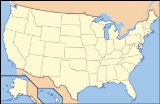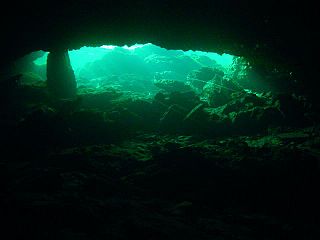
Peacock Springs State Park
Encyclopedia
Wes Skiles Peacock Springs State Park is a 733 acres (296.6 ha) Florida State Park
located on Peacock Springs Road, two miles (3 km) east of Luraville and on State Road 51
, 16 miles (25.7 km) southwest of Live Oak, Florida
. Activities include picnicking, swimming and diving, and wildlife viewing. Among the wildlife of the park are deer
, bobcat
s, raccoon
, squirrel
s, beaver
and otter
s, as well as turkey
, blue heron
and barred owl
s. The park name commemorates the work of diver and explorer Wes Skiles. Prior to 2010 the park was known as Peacock Springs State Park. Amenities include a nature trail, six sinkholes, and Peacock and Bonnet Springs, with miles of underwater caves popular with cave divers
. The two springs are tributaries of the Suwannee River
. The park is open from 8:00 am till sundown year round.
purchased approximately 481 acres (194.7 ha) for expansion of the park. This donation more than doubled the size of the park that was previously 252 acres (102 ha).
 The Peacock cave system is a karst
The Peacock cave system is a karst
environment in limestone
.
The Peacock Springs Cave system was first explored by Vasco Murray in 1956. The first map of the system was completed by the National Speleological Society
team leader, Sheck Exley
, in 1995. Exley's team made over 521 dives to complete the survey. A resurvey of the system was completed in 1996 by a team led by Michael Poucher. As of June 13, 2008, the Peacock cave system was the 24th longest underwater cave in the world at 7408 meters.
On April 25, 2002, the park stopped allowing divers to use Diver Propulsion Vehicle
s (DPV) as a means of protecting the system from damage.
It is one of the largest underwater caves in the continental United States
with over 28000 feet (8,534.4 m) of explored passageway. The cave system consists of seven major springs and sink holes, six of which are located within Peacock Springs State Park. Peacock Springs is a popular destination for cave divers all over the world and is extensively used to train new cave divers.
Florida State Parks
The Florida State Parks encompass the majority of the lands that fall under the authority of the Florida Department of Environmental Protection. There are 160 such entities, including nature reserves, recreation areas, and historic sites, which can be found in every corner of the state...
located on Peacock Springs Road, two miles (3 km) east of Luraville and on State Road 51
State Road 51 (Florida)
State Road 51 is a north–south route in north Florida. Its northern terminus is at the junction of US 41 and US 129. It runs southwards as the "secret" designation of US 129 to Live Oak, where it splits off and runs independently south to Steinhatchee. The Hal W...
, 16 miles (25.7 km) southwest of Live Oak, Florida
Live Oak, Florida
Live Oak is a city in Suwannee County, Florida. The city is the county seat of Suwannee County and is located east of Tallahassee, Florida. The population was 6,480 at the 2000 census. As of 2004, the population recorded by the U.S. Census Bureau is 6,828 ....
. Activities include picnicking, swimming and diving, and wildlife viewing. Among the wildlife of the park are deer
Deer
Deer are the ruminant mammals forming the family Cervidae. Species in the Cervidae family include white-tailed deer, elk, moose, red deer, reindeer, fallow deer, roe deer and chital. Male deer of all species and female reindeer grow and shed new antlers each year...
, bobcat
Bobcat
The bobcat is a North American mammal of the cat family Felidae, appearing during the Irvingtonian stage of around 1.8 million years ago . With twelve recognized subspecies, it ranges from southern Canada to northern Mexico, including most of the continental United States...
s, raccoon
Raccoon
Procyon is a genus of nocturnal mammals, comprising three species commonly known as raccoons, in the family Procyonidae. The most familiar species, the common raccoon , is often known simply as "the" raccoon, as the two other raccoon species in the genus are native only to the tropics and are...
, squirrel
Squirrel
Squirrels belong to a large family of small or medium-sized rodents called the Sciuridae. The family includes tree squirrels, ground squirrels, chipmunks, marmots , flying squirrels, and prairie dogs. Squirrels are indigenous to the Americas, Eurasia, and Africa and have been introduced to Australia...
s, beaver
Beaver
The beaver is a primarily nocturnal, large, semi-aquatic rodent. Castor includes two extant species, North American Beaver and Eurasian Beaver . Beavers are known for building dams, canals, and lodges . They are the second-largest rodent in the world...
and otter
Otter
The Otters are twelve species of semi-aquatic mammals which feed on fish and shellfish, and also other invertebrates, amphibians, birds and small mammals....
s, as well as turkey
Turkey (bird)
A turkey is a large bird in the genus Meleagris. One species, Meleagris gallopavo, commonly known as the Wild Turkey, is native to the forests of North America. The domestic turkey is a descendant of this species...
, blue heron
Heron
The herons are long-legged freshwater and coastal birds in the family Ardeidae. There are 64 recognised species in this family. Some are called "egrets" or "bitterns" instead of "heron"....
and barred owl
Owl
Owls are a group of birds that belong to the order Strigiformes, constituting 200 bird of prey species. Most are solitary and nocturnal, with some exceptions . Owls hunt mostly small mammals, insects, and other birds, although a few species specialize in hunting fish...
s. The park name commemorates the work of diver and explorer Wes Skiles. Prior to 2010 the park was known as Peacock Springs State Park. Amenities include a nature trail, six sinkholes, and Peacock and Bonnet Springs, with miles of underwater caves popular with cave divers
Cave diving
Cave diving is a type of technical diving in which specialized equipment is used to enable the exploration of caves which are at least partially filled with water. In the United Kingdom it is an extension of the more common sport of caving, and in the United States an extension of the more common...
. The two springs are tributaries of the Suwannee River
Suwannee River
The Suwannee River is a major river of southern Georgia and northern Florida in the United States. It is a wild blackwater river, about long. The Suwannee River is the site of the prehistoric Suwannee Straits which separated peninsular Florida from the panhandle.-Geography:The river rises in the...
. The park is open from 8:00 am till sundown year round.
Expansion
In 2006, The Trust for Public LandThe Trust for Public Land
The Trust for Public Land is a land conservation nonprofit founded in 1972 by Huey Johnson and based in San Francisco, California in the United States. TPL works throughout the United States to conserve land for people as parks, gardens, and other natural places.- TPL Conservation Initiatives :TPL...
purchased approximately 481 acres (194.7 ha) for expansion of the park. This donation more than doubled the size of the park that was previously 252 acres (102 ha).
Cave System

Karst topography
Karst topography is a geologic formation shaped by the dissolution of a layer or layers of soluble bedrock, usually carbonate rock such as limestone or dolomite, but has also been documented for weathering resistant rocks like quartzite given the right conditions.Due to subterranean drainage, there...
environment in limestone
Limestone
Limestone is a sedimentary rock composed largely of the minerals calcite and aragonite, which are different crystal forms of calcium carbonate . Many limestones are composed from skeletal fragments of marine organisms such as coral or foraminifera....
.
The Peacock Springs Cave system was first explored by Vasco Murray in 1956. The first map of the system was completed by the National Speleological Society
National Speleological Society
The National Speleological Society is an organization formed in 1941 to advance the exploration, conservation, study, and understanding of caves in the United States. Originally located in Washington D.C., its current offices are in Huntsville, Alabama...
team leader, Sheck Exley
Sheck Exley
-Biography:Exley is widely regarded as one of the pioneers of cave diving, writing two major books on the subject: Basic Cave Diving: A Blueprint for Survival and Caverns Measureless to Man published by Cave Books, , and establishing many of the basic safety procedures used in cave and overhead...
, in 1995. Exley's team made over 521 dives to complete the survey. A resurvey of the system was completed in 1996 by a team led by Michael Poucher. As of June 13, 2008, the Peacock cave system was the 24th longest underwater cave in the world at 7408 meters.
On April 25, 2002, the park stopped allowing divers to use Diver Propulsion Vehicle
Diver Propulsion Vehicle
A diver propulsion vehicle is an item of diving equipment used by scuba and rebreather divers to increase range underwater...
s (DPV) as a means of protecting the system from damage.
It is one of the largest underwater caves in the continental United States
United States
The United States of America is a federal constitutional republic comprising fifty states and a federal district...
with over 28000 feet (8,534.4 m) of explored passageway. The cave system consists of seven major springs and sink holes, six of which are located within Peacock Springs State Park. Peacock Springs is a popular destination for cave divers all over the world and is extensively used to train new cave divers.

